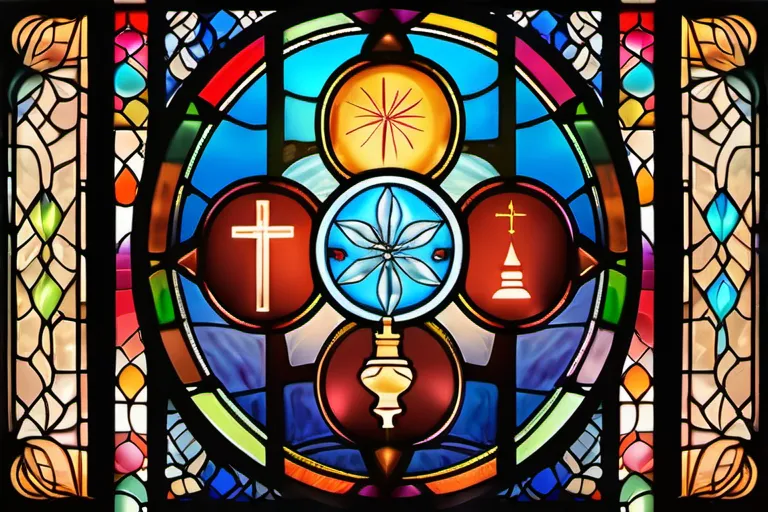Explore the history, meaning, and significance of various religious symbols across different faiths.
Religious symbols play a crucial role in shaping beliefs, practices, and traditions within various faiths. In this article, we delve into the fascinating world of religious symbols, exploring their origins, meanings, and cultural significance.
The Power of Symbolism
Imagine religious symbols as intricate keys, each opening a door to profound spiritual insights and beliefs. How do these symbols manage to encapsulate complex ideas and convey deep meanings? The answer lies in their power as tools for symbolic representation. Just like a map points us towards unexplored territories, symbols guide us through the vast landscapes of faith.
Consider the Om symbol in Hinduism. It is more than just a sound or a mark; it represents the essence of the universe and the divine. But how does such a simple gesture carry so much weight? The answer lies in its history and cultural context. This symbol has evolved over millennia, reflecting philosophical ideas and spiritual practices that have shaped the fabric of Hindu culture.
Similarly, the Cross in Christianity stands as a testament to the crucifixion of Jesus Christ. But what does it truly mean beyond this historical event? It is a symbol of redemption, forgiveness, and eternal life. How can such abstract concepts be conveyed so effectively through one simple shape? The cross’s enduring significance lies in its ability to evoke a range of emotions and beliefs, making the intangible tangible.
These symbols serve as metaphors that bridge the gap between human understanding and divine truth. They are like bridges built over vast oceans, connecting us to realms we can scarcely imagine. Each symbol has its unique story, reflecting the rich tapestry of human spirituality and our quest for meaning in a complex world.
Origins of Religious Symbols
Tracing the history of religious symbols, we embark on a fascinating journey that spans thousands of years and myriad cultures. These symbols have served as profound vessels for faith, often embodying complex beliefs in their simplest forms. Have you ever stopped to wonder how these symbols came to be such an integral part of our spiritual lives? Could it be that they are the visual poetry of our souls, painting vivid pictures of our innermost beliefs?
The origins of religious symbols can be traced back to prehistoric times. Early humans used natural elements like stones and animal bones as symbolic tools, believing them to hold spiritual power or communicate with deities. Over time, these rudimentary symbols evolved into more complex iconography that we recognize today in various religions.
- In Hinduism, the Om symbol, representing the essence of all creation and cosmic sound, has its roots deep in ancient Vedic texts. Its evolution from a simple syllable to a revered spiritual symbol highlights how symbols can transcend their initial meanings as they gain cultural significance.
- The Christian cross, with its cruciform shape, is a powerful metaphor for sacrifice and redemption. But did you know that the cross’s design has roots in earlier religious practices? The ancient Egyptian ankh, resembling a t-shaped cross, symbolized life and eternity long before the birth of Christianity. This parallel suggests that symbols can resonate across different belief systems, bridging time and cultures.
- Even more intriguing is the use of mandalas in Buddhism and Hinduism. These intricate geometric designs are meditative tools meant to mirror the universe and aid in spiritual contemplation. The meticulous creation of a mandala is akin to the act of weaving a tapestry of faith, each line and shape carefully crafted to hold meaning.
As we explore further into history, these symbols continue to evolve, adapting to new contexts while maintaining their core meanings. The journey of religious symbols is not just one of evolution but also of transformation, as they meet the changing needs of humanity’s evolving spiritual landscape.
Cross: A Universal Symbol
Imagine a symbol that transcends its origins, becoming a beacon of hope and faith across diverse cultures. The cross, a simple yet profound emblem, has woven itself into the fabric of human history and belief systems far beyond Christianity. Have you ever wondered why this shape holds such power? Why does it resonate with so many people, even those who may not believe in Jesus Christ?
The cross is more than just a piece of wood; it’s a metaphor for life’s burdens and the ultimate sacrifice. In Christian theology, it represents the crucifixion of Jesus Christ, whose death on the cross became the foundation of salvation. But the cross has not only been central to Christianity. Have you ever stopped to think about how symbols from different cultures can converge in such a meaningful way?
In many ancient civilizations, the cross-like symbol appeared in various forms. In Norse mythology, it was known as the Tyr’s Cross, representing courage and strength. Could this be why the shape feels so familiar, even to those who know little about its religious origins? The cross has also been a significant element in other faiths like Mithraism and Gnosticism, suggesting that this symbol carries deeper, more universal meanings.
Moreover, the cross’s influence extends beyond religion. It has inspired art, literature, and even everyday objects such as keys and jewelry. How often do you find yourself drawn to a piece of jewelry shaped like a cross without knowing why? The shape seems almost innate, a symbol that speaks directly to our souls.
The cross also embodies the concept of intersectionality—how different aspects of identity and belief intersect. It’s not just about religion; it’s about human resilience, redemption, and the enduring quest for meaning in life’s complexities. Could this be why the cross remains so potent and relevant even in today’s diverse and secular world?
The Star of David: Jewish Identity
The Star of David, also known as the Magen David, has been a symbol of Jewish identity for centuries. Have you ever wondered about its origins and significance? Did it always represent Judaism, or was there a time when it wasn’t widely recognized?
The history of this six-pointed star is rich and complex. It’s often said that the Star of David didn’t become an official symbol of Jewish identity until the 16th century, but its origins date back much further. Some believe it can be traced to ancient Mesopotamia or even biblical times, as a simple triangle within another triangle.
What makes the Star of David so significant is not just its shape, but what it symbolizes. It represents the unity and strength of the Jewish people, much like a fortress protecting them from harm. The star’s six points can be seen as reaching out in all directions, embracing all aspects of life and faith.
During World War II, the Star of David took on an even more profound meaning, becoming a symbol of resilience and hope for many Jews during the Holocaust. It was not just a religious emblem but a powerful sign that they would survive against all odds.
Today, you see the Star of David on Jewish homes, synagogues, and in various forms of art and jewelry. It serves as a reminder of the rich history and enduring spirit of Judaism. As we look at this symbol, we can’t help but wonder about its future—how it will continue to evolve and inspire generations to come.
Just like the cross is intertwined with Christianity, so too has the Star of David become inextricably linked with Jewish culture and identity. It’s more than just a geometric shape; it’s a profound expression of faith and community.
Crescent Moon and Star: Islamic Symbolism
The Crescent Moon and Star: Islamic Symbolism
Have you ever gazed up at the night sky and wondered about those shimmering celestial bodies? In Islam, the crescent moon and star hold a profound significance that extends far beyond their natural beauty. They are more than just astronomical phenomena; they symbolize guidance and hope in the darkest of times.
Imagine the crescent moon as a beacon, illuminating paths for Muslims to navigate through life’s challenges. Just as the moon waxes and wanes, reminding us of cycles of growth and decay, the crescent moon reminds us that change is constant and that guidance can be found in the night sky itself. It’s like a gentle whisper from Allah, guiding believers towards righteous paths.
The star, on the other hand, symbolizes guidance and direction. In Islam, stars are seen as celestial bodies that not only light up the night but also point to the way forward. Think of it as a lighthouse in the tumultuous sea of life, guiding ships safely to their destination. This is why many Islamic countries use this symbol on their flags—both as a reminder and a beacon for the faithful.
Historically, the crescent moon and star were used by early Muslim communities as they spread across different lands. It wasn’t just about conquest; it was also about spreading light and knowledge in the darkest corners of society. These symbols became more than just decorative—they represented a call to unity and shared purpose among Muslims worldwide.
So, next time you see these symbols adorning mosques or flags, take a moment to reflect on their deep-rooted significance. They are not just visual representations but living embodiments of guidance, hope, and the unifying power of faith.
The Lotus Flower: Buddhist Symbolism
The lotus flower, often seen adorning temples and texts, holds a profound significance in Buddhism, much like the crescent moon and star does in Islam. But have you ever wondered why this flower is so central to Buddhist teachings? The answer lies deep within the natural world and the spiritual realm.
The lotus grows in muddy waters yet blossoms into a pure, beautiful flower—much like the soul that rises from the darkness of ignorance to enlightenment. Imagine the lotus as a journey, starting from the murky depths where life’s challenges can weigh us down, only to emerge gracefully, cleansing ourselves with each step.
But its symbolism goes beyond just purity and transformation. The lotus also represents wisdom and truth, qualities that Buddhists aspire to achieve. Just as a lotus unfolds petal by petal, so too do we in our quest for understanding and enlightenment. Each unfolding petal is a lesson learned, each flower a reminder of the path ahead.
Buddhists often use the lotus as a metaphor for the Buddha himself—born from a lotus, he rose above the material world to bring light and wisdom to humanity. This image reminds us that even in the most challenging circumstances, there is always hope for growth and renewal.
The next time you see a depiction of the Buddha sitting on a lotus throne or holding a lotus, pause for a moment. Reflect on how this flower embodies the journey from suffering to peace, from darkness to light. The lotus is not just an ornamental symbol but a living reminder of what we can achieve through patience and perseverance.
Conclusion
 By understanding the rich history and symbolism behind these sacred icons, we gain a deeper appreciation for the diversity and complexity of human spirituality.
By understanding the rich history and symbolism behind these sacred icons, we gain a deeper appreciation for the diversity and complexity of human spirituality.











